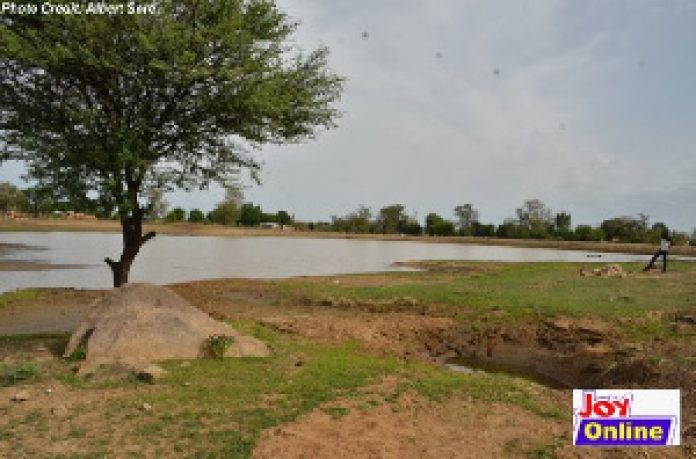A visibly distraught Anaba Aduko was torn between yielding to his urge to laugh and at the same time, holding back the urge. But after a few seconds of uncertainty, he yielded to the temptation.
His laughter was not the kind that usually follows a very funny joke from a comedian. At best, it can be described as something between a laugh and a simple smile.
He was asked about his thoughts on government’s One Village One Dam project ongoing in his community and whether or not he was satisfied with what government had constructed. And after a long pause, he said “we thought it was going to big dam, not something which cannot even contain water” – raising his two arms in the air and spreading them for emphasis – then shaking his head in disbelief as he pointed to the water body in front of him.
Anaba Aduko
He regrets how the lands given out freely for the construction of the dams have been wasted, because “if we had known that this was the sort of thing they were coming to do, I wouldn’t have given out the land.”
Anaba’s family land was given out for the construction of the dam at Zuarungu-Gono as part of the “One Village, One Dam” Initiative which according to him has turned out to be a rather disappointing move.
But he was not the only disappointed person we met.
In the last one month, I was joined by Joshua Asaah of A1 Radio in Bolgatanga and we visited six communities in four districts of the Upper East Region where some of the dams were being constructed under the initiative which is one of the government’s key campaign promises.
The main purpose of the collaboration with Joshua was to produce a TV series to put faces and voices to the story which had already made a huge impact.
The series has now ended but here are some key things I learned from the interviews we did with the people in the communities which I feel the government should not ignore if it intends to succeed with the policy and win the confidence of the people.
Ayopia Dam
Lack of community involvement has left residents aggrieved
We visited six communities – Ayopia and Kabre in the Bongo District, Zuarungu-Gono and Dachio in the Bolgatanga East District, Gadoone in the Bolgatanga Municipality and Kajelo in the Kasena-Nakana West District.
One thing was obvious in these communities – though community meetings were organised for government officials to discuss the government’s intentions to construct the dams, the community members and even their elders were ignored, once the constructions started.
At Kajelo in the Kasena-Nakana West district, for instance, the assemblyman, Hilary Aniakwo who is a known communicator for the current government, did not hide his feelings about how the contractor assigned to construct their dam adopted a sort of arrogant posture after the land was allocated for the dam.
He told us that the contractor suddenly disappeared from the site despite having earlier informing him and the community that he was going to work for two weeks.
Mr Aniakwo said: “He (the contractor) told us he was going to work for 15 days! But before we realized, the machines were off from this place. People were calling me and asking his whereabouts. I didn’t know he had already moved to another community”.
At Dachio in the Bolgatanga East district, the chief, Naba Akaliga II also said he was ignored after he allocated the land for the construction of the dam.
“When they came, myself and my elders provided them with the land to do the construction but when they started, I was not there. I don’t even know the person who supervised the work”, he said.
Kalejo Dam
Shoddy approach to construction of the dams has angered residents
While the government has said none of the dams being constructed across country under the initiative has been completed, the nature of work being done on these dams in some of the communities visited by the two reporters makes one wonder if contractors employed by government have taken the government’s initiative seriously.
Again at the Kajelo community, the contractor who worked on that dam appeared to have to simply excavated the soil, turned around and used the excavated soil to create an embankment around the pit by simply using his heavy-duty vehicles to compact the soil, without adding any rocks or other materials to make the embankment strong.
The community members at Kajelo said even they, who know next to nothing about construction knew that was wrong. But when they spoke up, the contractor ignored them.
Heavy rains told their truth. The community members came out in their numbers to see for themselves, what their new dam would look like with water in it. They ended up standing by and helplessly watching as a portion of the embankment crumble under the pressure of the rainwater.
“The whole place was flooded and the people of the community started jubilating that our constructed dam is now full of water.
“Some people even started preparing their pepper seedlings. Before we realized within 30 minutes, there was a disaster. The bank of the dam was washed away,” a livid Hilary Aniakwo, the Assemblyman lamented.
At the time of our visit, the portion of the embankment that collapsed had still not been repaired. It created a gap of about 10 meters within the embankment.
Portions of the embankment were loose and it appeared as though more of it would collapse if more rains were to come. However, about a week after our visit to Kajelo, the contractor went back and repaired the broken down portion of the embankment.
Also commenting on the dam being constructed in his community, the chief of Dachio said; “What (the work) they did, annoys me, so I don’t go there (to the site). When I am riding by, I don’t even want to look there”.
Naba Akaligab II
Naba Akaliga II also described the dam as a “football park” because he believed it could not hold the desired amount of water.
Some Dachio youth we met at the dam told the reporters that when the contractor left the site after about five days of work, it appeared as though he had levelled the land, rather than construct a dam or even a dugout.
One of the youth even volunteered to wade through the water to demonstrate to us that the dam was shallow.
At Gadoone, a community at Soe in the Bolgatanga Municipality, the drowning of three children in the dam there sparked an outcry among some of the residents who felt the accident could have been avoided if the right warnings signs had been put in place by the contractor.
Adogmbahiya Agale, a community member of Gadoone said; “we were very sad when those three children drowned here. Many of the community members were even angry and wanted the entire bank of the dam to be collapsed to allow all the water to escape because they felt the contractor did a poor job. But we calmed them down. Then the rains came and that portion of the bank collapsed”.
At Kabre and Zuarungu-Gono, some community members said the steep nature of the shores of their dams was trapping their animals.
“You know some of the animals like to walk into the water before they drink but some places (around the dam) are just steep so when the animals walk in, they just fall inside”, said Prosper Bayeta, a resident of Zuarungu-Gono.
All these issues surrounding the dams which are under a key government policy have left many of the people in the communities feeling that the policy is not being approached with the seriousness it deserves.
Zuarungu-Gono Dam
Unmet expectations
The ripple effect of the approach to the work on the dams and the defects in some of them is that; the expectations the people had when the government first engaged them on the dams have not been met.
Anaba Aduko, the farmer at Zuarungu-Gono who is mentioned earlier in this piece, said his family was excited that the community was going to a get “big dam” because they often go to the borehole to get water for their livestock during the dry season.
So for them, giving out the land which used to be a rice field for the construction of the dam, was a sacrifice they made for the benefit of the entire community.
However, it was turning out that what they envisaged as the dam, was not what was being constructed, at least judging from work that had been done so far.
According to the residents of Zuarungu – Gono, the contractor here too worked for just about a week and left the site, leaving the community members wondering if he was coming back or not.
Naba Akaliga II, the chief of Dachio also told us, that the land he and his elders allocated for the construction of the dam was a rice field.
He said “We were growing rice on that land and now it has been levelled like a football park. All the manure on it is gone. If the contractor fails to come back, then we will have to hold the government (accountable). He (the president) should compensate us”.
At Kajelo, Kabre and Ayopia, the residents complained that the dams were too small for irrigation which was the main reason for which the government told them it was constructing the dams in the first place.
Uncertainty about the exact specifications of projects In the run-up to the 2016 general elections, President Nana Addo Dankwa Akuffo-Addo, then flagbearer of the New Patriotic Party, made the “One Village, One Dam” campaign promise while on a campaign tour of the Upper East Region.
That day while addressing the traditional council, the president said; “As far as this part of the world is concerned, I want to go further and talk about one village, one dam to make sure that in every village, we have a functioning dam to support agriculture”.
The President cut the sod for the construction of the Ayopia dam in the Bongo district in July 2018. This also marked the official take-off of the “One Village, One Dam” Initiative. The President was on a tour of the Upper East Region.
One year on, we began our series of stories on the dams from the Ayopia community where residents told us that though their dam (which the President cut the sod for) was providing water for animals while some residents fetched the water for construction, the dam was too small for irrigation purposes.
When we put this concern before the Bongo District Chief Executive, Peter Ayinbisa, he said while the dam may not be what the people thought they were going to get, it was still serving some purposes.
He said; “those who are saying the dams are not properly constructed are our political opponent and you don’t expect them to say anything good about these dams.
“As it were, the people of Bongo are benefitting from these dams. Animals are drinking the water and people are fetching the water to reconstruct their houses. The people of Ayopia until now did not have that,” he added.
Gadoone Dam
The Assemblyman for Ayopia, Joseph Atule, on the other hand, said; “What I know is that this dam can be expanded. And if it had been done that way; to serve the purpose of dry season farming and for people to be fetching for domestic purposes, it would have been better than it is now.”
One thing was clear – none of the dams in the six communities we visited had any canals going to the nearby farmlands. And at every single one of the communities, the people said the dams were too small to irrigate farms.
At Gadoone, a community in Soe in the Bolgatanga Municipality, the people told us that when they enquired about how their small dam could irrigate their gardens, they were told that they would have to bring their own machines to pump water to their farms if they wanted to make gardens.
The government had made it clear before the initiative began, that the dams would help promote dry season farming. However, the dams the people are seeing in their communities, do not look as if they can serve that purpose.
In a statement responding to the opposition’s criticism of the “One Village, One Dam” Initiative, government said among other things;
“With reference to the model of the dams being constructed;
Each dam covers a land area of 2 hectares. The earth embankment wall has a maximum height of 5m. The depth of the small dam is also 5m. The length of the embankment wall ranges between 250m and 350m. The width of the embankment wall is 4m. At the central part of each dam is a dugout, which is the depression or the inner chamber of the dam. Each dam when completed is estimated to contain in excess of 30,000 cubic meters of water when full…”
For many of the people in these communities who are illiterate or semi-illiterate, the terms used above are difficult to understand. Therefore, a simpler alternative would be for government to show to the people of the communities and the entire country, pictures or drawings of what the dams would look like when completed. This has not been done so it still remains an uncertainty, what exactly the dams are supposed to look like.
A former Pro Vice-Chancellor of the University for Development Studies, Prof. David Millar said it will be difficult to benchmark the work done under the “One Village, One Dam” Initiative unless there is a specific dam that can be shown to the people as the type is that is being constructed.
Government’s shunning of the communities covered in the news
The impact of Joshua Asaah’s documentary led to many including the opposition NDC criticising the “One Village, One Dam” Initiative.
The Ministry of Information responded with a statement detailing the nature of the dams being constructed and insisted that none of the dams has been completed yet.
The statement also mentioned that only four of the dams had challenges which had been rectified. The four included the one at Kajelo, one of the communities we visited.
The minister for Special Initiatives, Hawa Koomson later visited some of the dams under the initiative. This was while the Joy News series on some of these dams (the same ones Joshua Asaah covered) was still ongoing.
The Minister visited some of the dams in other parts of the north and later came to the Upper East Region. However, she did not go to any of the communities in the Kasena-Nakana West, Bolgatanga East, Bolgatanga Municipal and the Bongo District where the stories that generated the recent media buzz came from.
Rather, the Minister went to the Garu and Tempane areas where she inspected some dams and expressed satisfaction at the nature of work done there.
Naturally, we got calls from people in the communities we visited. Calls came from Kajelo which had been mentioned in the press statement and from Gadoone where the three children had drowned.
Considering that their communities had been on the news, many concerned people from these communities were asking why the minister did not come to at least, interact with them and perhaps give them some assurances that the contractors working on their dams would return to the site. We did not have the answers to these questions. And this again left many of them disappointed.
Going forward
Government should re-engage all communities and their leaders if it intends to succeed with this initiative and win the trust of the people in these communities.
Pictures of the type of dams to be constructed should be shown to the people and published at least, around the sites. This way, people will know that work is not yet complete. And when it is finally complete, there should be no ambiguity about the success of the project.
By all means, the dams should have the capacity to irrigate farms in the areas where they are constructed. The contractors must be made to return to continue work on the current dams, as soon as possible and this time, work hand in hand with the leaders of the communities. This way, the people should feel part of the process and will voluntarily serve as watchdogs to ensure that the projects succeed.











